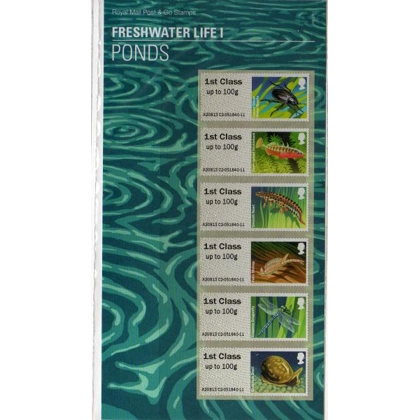Product Description
Pictorial Faststamps - Freshwater Life 1: Ponds - collectors strip from Hytech machine, 22 February 2013Freshwater covers just one per cent of the Earth’s surface, yet ten per cent of the world’s creatures live in this environment.
Half of the United Kingdom's ponds have been lost in the twentieth century. The series will feature some of the fish, amphibians and invertebrates that live in the UK’s ponds, lakes and rivers over a set of three issues. ‘Ponds’ is the first issue in the series, followed by ‘Lakes’ (20 June) and then ‘Rivers’ (20 September).
This is the Bureau pack with all stamps coded A2GB13 C2 051840-11 (this is the same code as the 2nd class Large Faststamp).
Lesser Silver Water Beetle
About 15mm long, the Lesser Silver Water Beetle, Hydrochara Caraboides, is a species of water scavenger beetle. Although the beetle is actually black, hairs on the underside of its body trap a silvery looking air bubble that enables the beetle to breathe underwater, giving the beetle its name. Eggs are laid in spring or early summer, and the larvae are often found from May to July, floating just below the surface. Adults are herbivores and feed on decaying plant matter, but the larvae are carnivores, and feed on water snails. In the UK it is found only in the Somerset Levels, Cheshire and North-East Wales. It is classified as an endangered species protected under the Wildlife and Countryside Act 1981.
Three-Spined Stickleback
Gasterosteus aculeatus is the larger of our two sticklebacks. It is usually 5cm long (but may reach, exceptionally, twice that length). In front of the dorsal fin there are the three spines that give the fish its name (though some individuals may have two or four). Along with the pelvic and anal spines these can be locked erect, making the fish extremely hard to swallow by a predator. The Stickleback can live in fresh, brackish or salt water and is found in ditches, ponds, lakes, backwaters, quiet rivers, sheltered bays, marshes, and harbours.
Smooth Newt
Also known as the Common Newt, Lissotriton Vulgaris is found throughout Europe except the far north, areas of Southern France and the Iberian peninsula. Females and non-breeding males are pale brown or olive green, often with two darker stripes on the back. Both sexes have an orange belly, although in females, it is paler. This is covered in rounded black spots. They have a pale throat with conspicuous spots. During the breeding season, males develop a continuous wavy crest that runs from their head to their tail, and their spotted markings become more apparent. They are also distinguishable from females by their fringed toes. Like other amphibians their eggs are laid in the water and hatch into tadpoles, which eventually develop into air breathing adults.
Fairy Shrimp
Chirocephalus diaphanous, is a beautiful, translucent crustacean, which lacks a carapace. It has a relatively large number of segments and bears 11 pairs of legs, fringed with bristles; the head curves downwards, and in males, the second pair of antennae are modified ‘claspers’ for grabbing females during mating. Fairy Shrimps swim around on their backs, propelled by constantly moving legs. They hatch during the cooler parts of the year, as water returns to their shallow ponds, which dried out during the summer. They reach maturity over winter, then lay eggs, which can survive long periods of drought and then die when their ponds dry out in spring. It is found in no more than 100 ponds in the whole of the UK. Fairy Shrimps are protected by the Wildlife and Countryside Act and can be found in Hampshire’s New Forest, on the edge of Dartmoor in Devon, on Salisbury Plain, in parts of the Sussex Weald, as well as in Oxfordshire, East Anglia and South Wales.
Emperor Dragonfly
Anax Imperator, is a large and powerful species of hawker dragonfly averaging 78mm in length. It is found in Europe, Africa and Asia. Males have a sky blue abdomen with a black dorsal stripe and an apple green thorax. Females have a green thorax and abdomen. The species live by ponds, gravel pits, and slow rivers, where they feed on other insects and tadpoles. Eggs are laid on pondweed and the larvae develop underwater as ferocious predators, feeding on invertebrates, tadpoles and even small fish.
Glutinous Snail
Myxas Glutinosa, is a small air-breathing freshwater snail. This snail is unusual in that it extends its almost transparent mantle to completely cover the shell when moving, giving the animal a glass-like appearance. It also makes the animal sticky to the touch, hence its common name. It is only found in very clear, clean ponds, lakes and canals. This species has undergone a big decline, and while it was once found throughout the UK, it is now known from only one site in Wales. As a result it is classified as endangered in the UK and protected under the Wildlife and Countryside Act 1981. The reasons for its decline are almost certainly due to water pollution particularly from nutrient enrichment.

